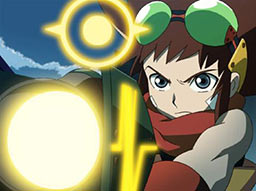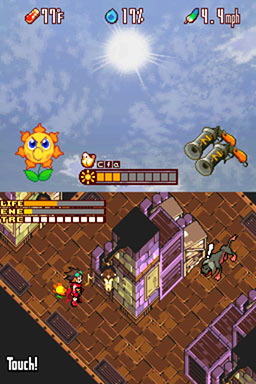Because Lunar Knights is such a solid little game, I had hoped the gameworld would be fleshed out; I hoped that I’d have enough new levels to allow me to upgrade all my weapons without returning to the same stages over and over. I wanted the many mechanics to continue to build on each other and each to be fully realized. Hell, while playing it I designed my own game (usually I charge to see my ace designs, but for the sake of this review I am willing to go hungry):
 |
|
Multiple high quality CG movies in a DS game? Yes, please.
|
Imagine Zelda in one expertly designed dungeon that has many facets closed off at any given point. As you progress you gain control over the weather but cannot change it at will, you must decide on the climate before descending into the dungeon, so choose well. In the frigid cold ice hardens and allows you to cross rivers and lakes, accessing normally cut off regions but walls of frost would close off other paths. The warm weather would reverse this and create lush plant life to climb and swing on. Wolves that normally exist in a temperate climate are shielded with ice armor, and in humid weather slimes become self reproducing viscous ooze. Even weapons react to the weather. Burning arrows won’t ignite in moist climates and wooden gear may be prone to combustion mid-use. And so on.
The game design was entirely ripped from Lunar Knights, but Lunar Knights never actually puts these ideas into full effect (or in some cases, doesn’t even try). A bonus chest here and there requires you to make it windy or humid, and a dungeon late in the game forces you to change the weather a few times in a half assed and forced puzzle. None of what I hoped for came true – significant production value went into a world that is never really fleshed out; design time was spent on a plethora of game mechanics that barely go anywhere.
 |
|
And another DS character does that hand out pose.
|
Konami succeeded in many ways, which makes the game ultimately more disappointing. Towing a coffin into space in order to fry a vampire with sunlight is awesome and is proof some love went into designing Lunar Knights. The bad guys are interesting and the moral quandary the game poses was actually enough to make me think. Plenty of games can lazily lob an ethics question at you (see Eternal Sonata’s “If I eat bread and my neighbor eats bread, are we really any different?”) but Lunar Knights uses its dilemma for the heart of its tale and I am still unconvinced humanity deserves to be saved (long live the vampires!).
One of your characters uses melee weapons and the other guns, and the variety is appreciated. Weapons are fun to upgrade and improving them will probably drive you to replay areas repeatedly. If you want to upgrade one of your many weapons (some of which are hidden and not mandatory pickups) you’ll need to either find raw materials from enemy drops (which takes forever) or just amass huge sums of money by killing thousands of skeletons and cerberi. Battles can get stale but the thrill of assigning stat points on the frequent level ups was enough to get me through them.
And then the plot stops short of achieving greatness. At some point in the dialogue, it is promised that you will have the choice of saving or condemning the world as we know it. If only this choice ever came. The game would have been much stronger if designers took the time to create one last, alternate dungeon and assortment of boss fights for jerks who want to side with evil (What is evil, anyway? If I kill and eat a cow I am good but if I kill and eat a cow with the severed leg of someone I just killed and ate all of a sudden I’m “evil”?).
 |
|
If you ever go into space, make sure to bring a levitating cat.
|
And the weapon system ends up falling short because there are very few instances when using guns actually works better than wailing on enemies with a sword. Your melee character will be so overpowered that you’ll likely use the other only if you, like me, are addicted to leveling and stat building. The easy design fix for this problem would’ve simply been throwing in some vicious status effects (petrification, instant death, and herpes would keep people away from an enemy) or just enemies that cause so much damage it’s irrelevant how much defense your close combat character has.
Why doesn’t Lunar Knights live up to its potential? The most obvious answer is that few games truly fulfill every promise they make to the gamer. Fine, but I’ve noticed console games tend to feel bigger and more complete than handheld titles. This may sound hilariously stupid – of course handheld games are smaller. I don’t just mean graphics and sound. Why are DS games smaller in scope and game mechanics? Would Lunar Knights have gone from a great handheld game to a poor one if the quest lasted five more hours and the mechanics were allowed to fully blossom, like an eight year old boy at a NAMBLA meeting?
Developers don’t seem willing to put in the effort on the DS. The system is home to many great games, but most of them are Nintendo developed, and even their Phantom Hourglass ended much too soon. Looking at third party support shows very few quality titles that are full traditional games. The Castlevanias, Contra 4 and Lunar Knights are the closest we get, and they are all from Konami. Where are the other grand action titles or platformers?
 |
|
The top half of the screen picks up The Weather Channel.
|
The RPG situation is even more dismal. Partners in Time is pretty cool, but beyond that Nintendo published game and Pokemon, there isn’t much. Etrian Odyssey is fun but, like Lunar Knights, fails to live up to its potential. Luminous Arc is mostly meh and Dragon Quest Rocket Slime is an action RPG (and a short and easy one at that). Until Dragon Quest IX, I’m not sure there will be any solid RPGs on the handheld despite its having launched in 2004.
Pretend RPGs don’t work on handhelds. Adventure games sure do, yet beyond the Phoenix Wright saga, Hotel Dusk, and some crappier games from Cing, the DS adventure genre is barren (in America). The DS game library does not look like the library of a “winning” system. Mario Kart and Nintendogs may be the handheld’s Grant Theft Auto and Resident Evil, but then where is the DS’s Metal Gear Solid, Gran Turismo, Devil May Cry, God of War, Virtua Fighter 4, Okami, Prince of Persia, Final Fantasy, Klonoa, Ratchet and Clank, Shadow of the Colossus, Rayman, Splinter Cell, Silent Hill… And where is the Western support? No, not you Ubisoft. Go away, we don’t want any.
Besides the typically potent first party lineup, the DS is almost as unsupported as any other Nintendo console (post 1995). The idea that the Wii will follow in the DS’s footsteps is promoted by Nintendo fans and well wishers. This is not as great a thing they make it out to be. I love my DS, but it’s far from a third party powerhouse. There are plenty of good and quirky titles worth playing – Meteos, Trauma Center, Rune Factory, Geometry Wars and so on – but the list of truly ambitious DS titles is pathetically short and mostly filled with games published by Nintendo.
 |
|
Boss battles not representative of gameplay.
|
There is strong evidence that the Wii has already followed in the footsteps of the DS. Besides the first party efforts there have been few attempts at big games. No More Heroes and Red Steel have been the only attempts besides the Resident Evil 4 port; perhaps somewhat paradoxically, I’d include Zack & Wiki. Then again, if all the smaller games were of the same quality as Zack & Wiki (which was clearly made with oh so tender touches and loving, sensual care) and Trauma Center, I’d be much less concerned about the dearth of bigger titles.
Perhaps I’m missing the point of these new Nintendo systems by calling for more big ambitious games. But why can’t I want both small innovative games and epic RPGs on the same console? And why couldn’t Konami fit more than three shmup levels into Lunar Knights?

